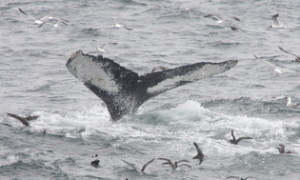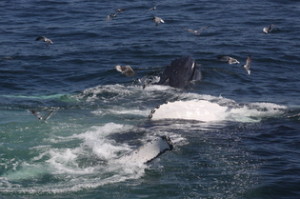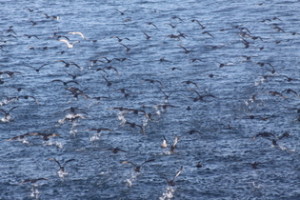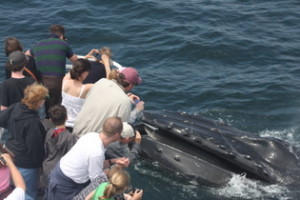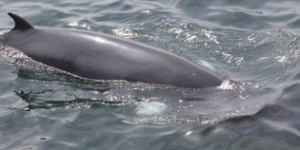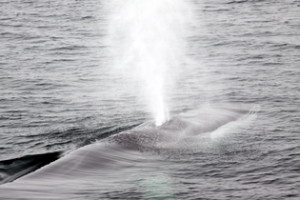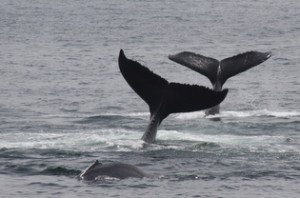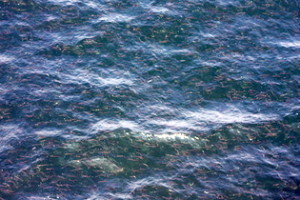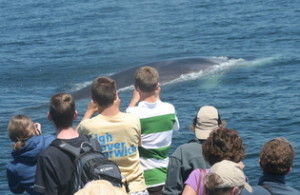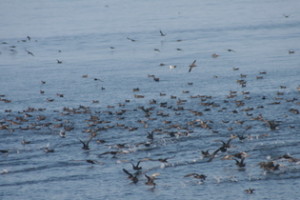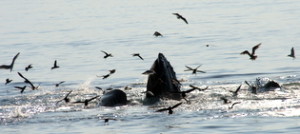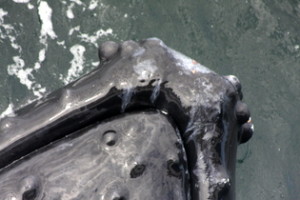June 25 to July 1
After watching the humpbacks on deep foraging dives for much of last week, we were pleased to see that the prey had been pushed closer to the surface by June 25. We spotted 6 humpbacks, including Stub, Pogo, Fracture, Abrasion, Scrape and Walrus as they moved northward along the backside of Cape Cod.
As they gradually worked their way along the edge of the Cape, they began to blow synchronous bubble nets, lunging through these ephemeral spirals to engulf the millions of sandlance that had been trapped by the net. For years we’ve watched humpbacks blow these complex nets to capture their prey, but every year we learn more about it. Recently, NOAA scientists used temporary suction cup tags to derive 3-D visualizations of how these nets are formed, and in doing so, discovered a new bubble net tactic called the “double loop”. In this feeding tactic, a team of humpbacks will blow one spiral of bubbles, smack the surface of the water, and lunge back up through the loop to scoop of the food. This study also discovered what scientists had previously suspected — that frequently whales that had no role in creating the bubble net will swoop in and steal mouthfuls of fish that other whales had worked so hard to trap! For more on this study, check out this article.
On June 26 we returned to the same location off the Peaked Hill and found that the small group we had seen yesterday had grown by at least 4 individuals. Some new flukes in the mix included Apex and Coral. Coral is easy to spot from the white scar in the front of the blowholes. Coral also has a very distinct fluke — white with thin scars along the trailing edge.
There were a total of 11-14 humpbacks in the area, as well as 4 Minkes, and dozens of Sooty Shearwaters in the area. The humpbacks continued to bubble net and surface lunge intermittently. One naturalist noted that most of the humpbacks in the group were males, with the exception of Pogo, whose sex is unknown, and Apex, who has had 10 calves in her lifetime.
On June 27 we planned to head back to the same spot, but we first made a stop right off Race Point to take a quick look at a fin whale which had surfaced. While waiting for it to re-emerge, we watched as an enormous school of bluefish swam under the bow. A gray seal also appeared, probably looking to snack on one of these oily fish!
After that first brief appearance, the fin whale never came back up, so we continued our trek toward Peaked Hill. There, we found Fracture, Pogo, and Coral engaging in coordinated bubble net feeding.
Fracture
We watched with amusement at Pogo’s unusual feeding behavior. Every time this humpback came up with a mouthful of food, it would immediately roll over on its back and raise its flipper in the air!
Meanwhile, aboard the Dolphin VIII, major excitement ensued as we watched a fishing boat land a huge bluefin tuna. Bluefin tuna can grow to be at least 500 pounds! Like the whales, these animals are highly migratory and are attracted to the highly productive waters off of Cape Cod for their rich food resources.

On the evening trip, we traveled to the same area, but by that time, there was no sign of that group of feeding humpbacks! Luckily, we got a call from the Provincetown Center for Coastal Studies which was out on their vessel, the R/V Ibis.
They pointed us to a spot off of Highland Light where there were 8-10 humpbacks, as well as several Minkes and hundreds of Sooty Shearwaters. The Sooty Shearwater has the world record for the longest bird migration. One Sooty Shearwater in the Pacific was tagged and recorded travelling over 40, 000 miles in a single year! These birds feed on the same small schooling fish that the humpbacks favor and can often be seen in association with feeding whales. This evening, the water was so calm that you could see the gull-sized birds diving underwater in pursuit of their prey.
The clattering sound of these shearwaters running on the water prior to take-off was dramatic! The humpbacks lunged with open mouths through schools of fish, but also became more active in other ways. Spike, first seen in 1985 lobtailed in between lunges, and one unidentified whale even breached!
Spike
Naturalists aboard the Dolphin VII, VIII, and IX agreed that on June 28th we had the most whales that we’d seen so far this month. Morning trips logged in counts of 11 humpbacks, including Coral, who surfaced right under the bow of the Dolphin VIII. The Dolphin Fleet abides by the whale watching guidelines set forth by the National Marine Fisheries Service, meaning that we don’t intentionally approach whales at this proximity; however, at times, these curious humpbacks will surface very close to our vessel!
As the day went on, more and more humpbacks kept moving into the area until the were all clustered near the Peaked Hill Bars until we counted over 20 individuals. That’s when the feeding frenzy began! We observed very dynamic groups as humpbacks would join together to blow huge rings of bubbles, trapping their prey inside complex bubble nets. At one point, as many as 8 humpbacks, including Joy, Fracture, Coral, Entropy, Stub and Pogo were working together to form one of these nets!
While some humpbacks used bubble net tactics to corral schools of fish, others used their powerful tails to stun fish near the surface before lunging through the confused school.
On the evening trip, we headed back to the Peaked Hill area and had close looks at a trio of whales, including Thalassa, the 1985 calf of Salt, as well as Abrasion and Stub. We made our way further to the east to try to relocate the feeding whales. In spite of the encroaching fog, we were able to find that a group of 5 humpbacks were still scooping up giant mouthfuls of sand lance. We had some great looks at these feeders before heading home for the evening.
On June 29th, we didn’t have to travel far before finding signs of life. As we rounded Race Point, there were hundreds of Wilson’s storm petrels, which are small pelagic birds that feed on plankton. Swimming beneath the feeding petrels were at least 10 Minke whales, whose pointed rostrums would break the surface, providing us with a fleeting glimpse of these elusive creatures.
Once we rounded the point, our first mate spotted a humpback feeding frenzy going on among the tuna fleet, and we set off to see if we could top the previous afternoon’s amazing looks. Once we arrived, we followed a big flock of birds towards Highland Light, where there was a multi-species feeding frenzy! A huge school of sand lance could be seen splashing at the surface trying to avoid the hungry jaws of the bluefin tuna, Atlantic white sided dolphins, Minkes and fin whales that were all in pursuit of these fish. As Sooty shearwaters, terns, and gulls swooped down to grab these fish for themselves, the tuna and the sand lance zipped along right below the surface, visibly agitated by the shadow of the birds.
Perhaps trying to avoid the “crowd”, we noticed that the group of humpbacks had moved about a mile away, and we headed towards them. Soon afterwards, they started a feeding frenzy of their own, creating huge bubble nets, similar to the day before. Pogo, Fracture, Stub, Xylem, Abrasion, Stub and Springboard were all in the mix.
The whales took a break from feeding mid-day, but were still around to give us great looks. On both the morning and afternoon trips we got excellent looks at two enormous fin whales, Sunspot and Cusp. We suspected from their slow surface rolls that they might have been feeding at depth, but we couldn’t be sure.
The feeding resumed later, with Thalassa, Springboard and Spike all making appearances between their bouts of feeding.
Just as we thought the trip couldn’t get any more exciting, Jabiru interrupted the feast with a huge breach!
Compared to the excitement of the previous day, June 30th was relatively low-key. There were still many whales in the area, but they appeared to be resting after their huge feeding bout. One of our naturalists was amused to see that the whales were so full that despite the millions of sand lance still swimming around, the whales weren’t showing any interest at all!
Luckily, there were still many interesting sights to behold. We were excited to see one of our first mother and calf humpback whales in a long time. Bolide, a 14 year old female, was traveling slowly with her third calf by her side.
While it’s usually the humpbacks that steal the show, today the fin whales proved more active than their more gregarious counterparts. Sunspot and Cusp, two fin whales seen traveling side by side for the past few days, were rolling on their sides and appearing right off the bow of the boat!
We caught up with these fin whales on our afternoon trip, and followed along side of them as they booked it to the south. The waters were flat and glassy, and soon we could see huge flocks of birds ahead of us.
As it happened, these fin whales led us right to a pile of feeding humpbacks! Hundreds of shearwaters filled the skies as Level, Echo, and Tectonic blew clouds of bubbles and emerged with full mouths. After a mid-afternoon snooze, these whales were ready to feed again!
As we were watching these behemoths gorge themselves on fish, we also started to notice smaller heads popping up here and there. A whole herd of seals were making their way toward the beach, and were probably attracted to the larger fish that were no doubt in the region!
Except for a few sporadic gulps here and there, the feeding had mostly subsided by July 1st, but it seemed like the humpbacks were doing practically everything else! The whales had returned to the Peaked Hill bars area, and were highly active — breaching, flippering and lobtailing throughout the afternoon! Stub, a male first seen in 1979 made numerous appearances throughout the day, and even spent much of the mid-day trip lobtailing!
Stub can be identified by his almost non-existent dorsal fin. While many scars and injuries on our humpbacks are from anthropogenic sources like ships and fishing gear, we tend to see some of our older males with lots of scrapes and scars on their body from the competitive behavior they engage in when they are in their winter mating grounds. These humpbacks will breach and ram into each other to vie for female attention, although their injuries are rarely critical.
Several trips also experienced rare close boat approaches from one of our most notorious humpbacks–Colt. Colt is also a male and is known for holding boats hostage — swimming back and forth underneath them so they can’t move back, even when they are late for the next trip!
Finally, we were pleased to see that the mother calf pairs are finally starting to return. We had a new sighting of a pair today, although we were not able to recognize the mother from our on-board catalog.
Here’s where we went this week:






